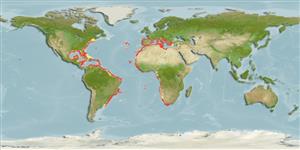Common names from other countries
Environment: milieu / climate zone / depth range / distribution range
Ekologi
; kisaran kedalaman 10 - 682 m (Ref. 62709). Tropical; 46°N - 38°S, 98°W - 37°E
Atlantic Ocean and the Mediterranean: from USA (Massachusetts, and Virginia to south Florida), West Indies, Central America and Brazil (Rio de Janeiro to Rio Grande do Sul) to Western Africa, including Canary and Madeira Islands, to Mediterranean Sea, and northeastern Atlantic from Spain to Portugal. Temperate to tropical.
Length at first maturity / Size / Weight / umur
Maturity: Lm ? range ? - ? cm Max length : 1.5 cm CW jantan/; (Ref. 93549)
Carapace width range: 1.22 to 1.47 cm (Ref. 93549). Maximum depth from 95880. Found on moderate depths from 10 to 679 m on mud, muddy sand, sandy and muddy detritus, coralline algae, calcareous algae, slightly sandy mud with funiculines, alcyonarians in mud, and reddish gravel with shell debris (Ref. 62709). In general, members of the family Homolidae are carnivorous (Ref. 107107).
Life cycle and mating behavior
Kematangan | Reproduksi, perkembang biakan | Pemijahan | telur-telur | Fecundity | Larva
Members of the order Decapoda are mostly gonochoric. Mating behavior: Precopulatory courtship ritual is common (through olfactory and tactile cues); usually indirect sperm transfer.
rujukan utama
Acuan | Koordinator | mitra
Coelho Filho, P.A. 2004. (Ref. 2364)
Status IUCN Red List (Ref. 130435)
status CITES (Ref. 108899)
Not Evaluated
Not Evaluated
penggunaan manusia
| FishSource |
Alat, peralatan
informasi lanjut
Umur / Saiz
Pertumbuhan
panjang-berat
panjang-panjang
Morfologi
Larva
Kelimpahan
Sumber internet
Estimates based on models
Preferred temperature
(Ref.
115969): 12.2 - 23.2, mean 15.2 (based on 354 cells).
kategori harga
Unknown.
